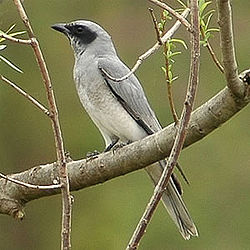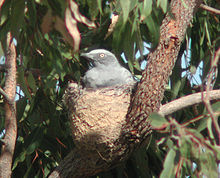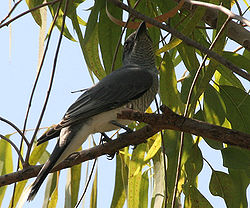- Cuckooshrike
-
Cuckooshrike 
Black-faced Cuckooshrike
Coracina novaehollandiaeScientific classification Kingdom: Animalia Phylum: Chordata Class: Aves Order: Passeriformes Suborder: Passeri Family: Campephagidae
Vigors, 1825Genera - Coracina
- Campochaera
- Lalage
- Campephaga
- Pericrocotus
- Hemipus
The cuckooshrikes and allies in the Campephagidae family are small to medium-sized passerine bird species found in the subtropical and tropical Africa, Asia and Australasia. The roughly 85 species are found in eight (or nine) genera which comprise five distinct groups, the 'true' cuckooshrikes (Campephaga, Coracina, Lobotos, Pteropodocys and Campochaera) the trillers (Lalage), the minivets (Pericrocotus), the flycatcher-shrikes (Hemipus). The wood-shrikes (Tephrodornis) were often considered to be in this family but are probably closer to the helmetshrikes or bushshrikes. Another genus, Chlamydochaera, which has one species, the Black-breasted Fruithunter was often placed in this family but has now been shown to be a thrush (Turdidae).
Contents
Taxonomy
Cuckooshrikes are closely related neither to the cuckoos nor to the shrikes; the name probably comes from the grey colour of many of the cuckooshrikes. Some of the species also bear a superficial resemblance to cuckoos, and have a similar undulating flight. The grey colouration has led to one of their other names, the greybird. In some parts of the world they have also been known as caterpillar-birds, a name derived from their diet. They are in fact thought by some to be closely related to the Old World orioles (Oriolidae), although they differ strongly in some morphological characteristics (such as skull morphology and the arrangements of feathers on the wing).
Description
Overall the cuckooshrikes are medium to small arboreal birds, generally long and slender. The smallest species is the Small Minivet at 16 cm (6.3 in) and 6-12 grams (0.2-0.4 oz), while the largest is the South Melanesian Cuckooshrike at 35 cm (14 in) and 180 grams (6 oz).[1] They are predominantly greyish with white and black, although the minivets are brightly coloured in red, yellow and black, and the Blue Cuckooshrike of central Africa is all-over glossy blue. The four cuckooshrikes in the genus Campephaga exhibit sexual dimorphism, with males that have glossy black plumage and bright red or yellow wattles, the females having more subdued olive-green plumage.[2] The genus Coracina is not monophyletic.[3]
Habitat
Of the 84 species of cuckooshrike, the majority are forest birds. Some species are restricted to primary forest, like the New Caledonian Cuckooshrike, others are able to use more disturbed forest. Around eleven species use much more open habitat, one Australian species, the Ground Cuckooshrike being found in open plains and scrubland with few trees.
Behaviour
The 'true' cuckooshrikes are usually found singly, in pairs, and in small family groups, whereas the minivets, flycatcher-shrikes and wood-shrikes more frequently form small flocks. There is a considerable amount of variation within the family as a whole with regards to calls, some call very infrequently and some, principally the minivets, are extremely vocal.
These are mainly insectivorous, and will take large hairy caterpillars. They have also been recorded eating small vertebrates, and some fruit, seeds and other plant matter.[2]
Information about the breeding of this family is incomplete, with many species having never been studied. In all the species studied the cuckooshrikes are territorial; in species that do not migrate these territories are maintained year round. Cuckooshrikes are monogamous, with the pair bonds apparently lasting throughout the year. Only one instance of non-monogamous breeding has been recorded, an instance of polygyny in White-winged Trillers in Australia, where one male aided two females in raising their young. Several species of cuckooshrike exhibit cooperative breeding. About four blotchy white, green or blue eggs are laid in a cup nest in a tree. Incubation is about two weeks.
Taxonomic list of Campephagidae
FAMILY: CAMPEPHAGIDAE
- Genus Coracina
- Ground Cuckooshrike, Coracina maxima
- Large Cuckooshrike, Coracina macei
- Sunda Cuckooshrike, Coracina larvata
- Javan Cuckooshrike, Coracina javensis
- Slaty Cuckooshrike, Coracina schistacea
- Wallacean Cuckooshrike, Coracina personata
- South Melanesian Cuckooshrike, Coracina caledonica
- North Melanesian Cuckooshrike, Coracina welchmani
- Black-faced Cuckooshrike, Coracina novaehollandiae
- Stout-billed Cuckooshrike, Coracina caeruleogrisea
- Bar-bellied Cuckooshrike, Coracina striata
- Cebu Bar-bellied Cuckooshrike, Coracina striata cebuensis - extinct (early 20th century)
- Pied Cuckooshrike, Coracina bicolor
- Moluccan Cuckooshrike, Coracina atriceps
- Buru Cuckooshrike, Coracina fortis
- Cerulean Cuckooshrike, Coracina temminckii
- Barred Cuckooshrike, Coracina lineata
- Boyer's Cuckooshrike, Coracina boyeri
- White-rumped Cuckooshrike, Coracina leucopygia
- White-bellied Cuckooshrike, Coracina papuensis
- Hooded Cuckooshrike, Coracina longicauda
- Halmahera Cuckooshrike, Coracina parvula
- Pygmy Cuckooshrike, Coracina abbotti
- New Caledonian Cuckooshrike, Coracina analis
- White-breasted Cuckooshrike, Coracina pectoralis
- Blue Cuckooshrike, Coracina azurea
- Grey Cuckooshrike, Coracina caesia
- Grauer's Cuckooshrike, Coracina graueri
- Madagascar Cuckooshrike, Coracina cinerea
- Mauritius Cuckooshrike, Coracina typica
- Reunion Cuckooshrike, Coracina newtoni
- Cicadabird, Coracina tenuirostris
- Maros Cicadabird, Coracina tenuirostris edithae - disputed; extinct (mid-20th century)
- Blackish Cuckooshrike, Coracina coerulescens
- Cebu Blackish Cuckooshrike, Coracina coerulescens altera - possibly extinct (early 20th century?)
- Marinduque Blackish Cuckooshrike, Coracina coerulescens deschauenseei - possibly extinct (late 20th century?)
- Pale-shouldered Cicadabird, Coracina dohertyi
- Sula Cicadabird, Coracina sula
- Kai Cicadabird, Coracina dispar
- Black-bibbed Cicadabird, Coracina mindanensis
- Sulawesi Cicadabird, Coracina morio
- Pale Cicadabird, Coracina ceramensis
- Black-shouldered Cicadabird, Coracina incerta
- Grey-headed Cuckooshrike, Coracina schisticeps
- Black Cicadabird, Coracina melas
- Black-bellied Cuckooshrike, Coracina montana
- Black-bellied Cicadabird, Coracina holopolia
- McGregor's Cuckooshrike, Coracina mcgregori
- Indochinese Cuckooshrike, Coracina polioptera
- White-winged Cuckooshrike, Coracina ostenta
- Black-winged Cuckooshrike, Coracina melaschistos
- Lesser Cuckooshrike, Coracina fimbriata
- Black-headed Cuckooshrike, Coracina melanoptera
- Genus Campochaera
- Golden Cuckooshrike, Campochaera sloetii
- Genus Lalage
- Black-and-white Triller, Lalage melanoleuca
- Pied Triller, Lalage nigra
- White-rumped Triller, Lalage leucopygialis
- White-shouldered Triller, Lalage sueurii
- White-winged Triller, Lalage tricolor
- Rufous-bellied Triller, Lalage aurea
- White-browed Triller, Lalage moesta
- Varied Triller, Lalage leucomela
- Black-browed Triller, Lalage atrovirens
- Samoan Triller, Lalage sharpei
- Polynesian Triller, Lalage maculosa
- Long-tailed Triller, Lalage leucopyga
- Norfolk Island Triller, Lalage (leucopyga) leucopyga - extinct (1976)
- Genus Campephaga
- Petit's Cuckooshrike, Campephaga petiti
- Black Cuckooshrike, Campephaga flava
- Red-shouldered Cuckooshrike, Campephaga phoenicea
- Purple-throated Cuckooshrike, Campephaga quiscalina
- Western Wattled Cuckooshrike, Campephaga lobata
- Eastern Wattled Cuckooshrike, Campephaga oriolina
- Genus Pericrocotus
- Rosy Minivet, Pericrocotus roseus
- Brown-rumped Minivet, Pericrocotus cantonensis
- Ashy Minivet, Pericrocotus divaricatus
- Small Minivet, Pericrocotus cinnamomeus
- Ryūkyū Minivet, Pericrocotus tegimae
- Fiery Minivet, Pericrocotus igneus
- Flores Minivet, Pericrocotus lansbergei
- White-bellied Minivet, Pericrocotus erythropygius
- Long-tailed Minivet, Pericrocotus ethologus
- Short-billed Minivet, Pericrocotus brevirostris
- Sunda Minivet, Pericrocotus miniatus
- Scarlet Minivet, Pericrocotus flammeus
- Gray-chinned Minivet, Pericrocotus solaris
- Genus Hemipus
- Bar-winged Flycatcher-shrike, Hemipus picatus
- Black-winged Flycatcher-shrike, Hemipus hirundinaceus
References
- ^ National Geographic Complete Birds of the World by Jonathan Alderfer. National Geographic (2009), ISBN 978-1426204036.
- ^ a b Clancey, P.A. (1991). Forshaw, Joseph. ed. Encyclopaedia of Animals: Birds. London: Merehurst Press. pp. 176. ISBN 1-85391-186-0.
- ^ Knud A. Jønsson, Martin Irestedt, Jerome Fuchs, Per G.P. Ericson, Les Christidis, Rauri C.K. Bowie, Janette A. Norman, Eric Pasquet, Jon Fjeldsa (2008) Explosive avian radiations and multi-directional dispersal across Wallacea: Evidence from the Campephagidae and other Crown Corvida (Aves). Molecular Phylogenetics and Evolution 47:221–236
- del Hoyo. J., Elliott, A., Sargatal, J., (eds), Handbook of the Birds of the World, Volume Ten, Cuckoo-shrikes to Thrushes, ISBN 84-87334-72-5
External links
- Cuckooshrike videos on the Internet Bird Collection
Categories:- Campephagidae
Wikimedia Foundation. 2010.


